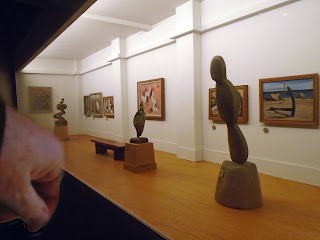I looked at the use of models a while ago as a way of thinking about the visualisation of certain ideas, but haven't really explored the full potential of working in this way. If the model is good enough it can be an artwork in its own right, and the idea of miniaturisation is itself a powerful concept, one that can take us from a God like viewpoint, whereby we survey the world we have created from above, via ideas associated with childhood, to the power of the minute, the fascination of the crafting of something smaller and smaller.
Bjarke Ingels’ Twisting High Line Towers installation is an extreme example of how a model can be used to powerfully engage an audience. Architects are very used to presenting their ideas as models, in fact without the models they would not be able to communicate their ideas to potential clients, but in Ingels' case he develops a particularly viewer centric way of making sure you would remember the experience of looking at his proposal. He uses both traditional modelling techniques and enhanced spatial dynamics by using mirrors, so that his audience is 'immersed' into the proposed project.
Bjarke Ingels Installation
The miniature can be something that holds such a deep fascination that some artists focus on tiny worlds as things in their own right.
Slinkachu
Slinkachu has made a career out of the idea of developing miniature art installations that comment on consumer culture and Joshua Smith has focused on the miniaturisation of buildings.
Joshua Smith
Locally the artist Hondartza Fraga has in response to not being able to work between her gallery in Spain and her Leeds studio because of covid, developed a model art gallery, which she calls 'Beyond Scale'. This is something something that the Pallent House Gallery in Chichester and in Leeds the artist Laurence Malloy have both in the past managed to also undertake very successfully. In Chichester the Pallent House Gallery houses two small model galleries. The 34 Gallery in particular hosts miniature works specially constructed for it by Paul Nash, Ivon Hitchens, Augustus John and Ben Nicholson as well as sculptures by Barbara Hepworth and Henry Moore. It is a mini-collection of the best of British art between the wars.
The 34 Gallery in Pallent House
Laurence Malloy's 'Delicate Matter' gallery was a thirty-six inch art gallery with a mandate to enable ambitious new contemporary art by emerging artists. This miniature gallery was also an artwork in its own right that sought to question the validity and nature of formal art spaces by enabling Malloy to "act as the gallery’s curator for over three years. This allowed him to explore and then play upon the mechanisms, nuances and absurdities of the gallery system in the UK".
Delicate Matter gallery
Making models to work from is a very old tradition. Michelangelo in particular was very fond of working his ideas out as wax models.
Michelangelo model 'Slave' wax
Anthony Caro is probably the best known English modern artist that used the idea of making models right up until his death. Caro: maquettes
In the Goodwood sculpture park the Cass foundation has a gallery that hosts maquettes and models of the full-sized work that sits in the grounds of the sculpture park. Occasionally they will also put on exhibitions of the maquettes in their collection. Cass Foundation exhibitions of maquettes
Sarah Anne Johnson, House on Fire
The miniature has a certain weirdness that makes it a very suitable medium to carry weird stories. In the late 1950s, Sarah Anne Johnson’s grandmother entered treatment for extreme depression at the Allan Memorial Institute in Montreal, where the renowned Doctor D. Ewen Cameron treated her. Unbeknownst to anyone outside of the institute, her treatment was part of the covertly sponsored MK-ULTRA mind-control program, where the CIA conducted brainwashing experiments involving LSD, shock therapy, medically induced prolonged sleep, and sensory deprivation. The dolls house becomes a depiction of physical and psychological anguish, filtered through childhood memories and first- and second-hand accounts of the story.
Lori Nix and Kathleen Gerber create miniature models of post-apocalyptic scenes that they then photograph. Because their work consists of models and not real places, it creates a safe space to think about issues such as a coming apocalypse, global warming or other disasters. These spaces are meditative and full of awful possibility.
Emanuele Coccia states that, 'Sensible life is the life that images themselves have sculpted and made possible', she goes on to say...in order for it to be given as experience and as a dream, "it is necessary that the sensible exists."' The quote within a quote, is because Coccia was herself quoting The 'De Anima' of Alexander of Aphrodisias, which just goes to show how old some of these ideas are. Somehow its easier to see that the life of a model has a sensible existence than the full blown our sized reality, we need to 'see it' in order to believe its existence and a model world is so much easier to grasp than the complicated interconnectedness of reality. It is from this world that emerges the 'living doll' or automaton. Puppets are uncanny in their life, their eerie sensibility often being more memorable than human actors playing the same roles. The voodoo doll is a more extreme aspect of this tradition.
So if the restrictions of covid lockdown feel as if they are preventing you making at a scale you would have done, perhaps not all is lost, and there is another scale waiting to be explored, that of the tiny and the miniature, a world that might be small but which has enormous potential for heightened emotional engagement and one which perhaps lies at the core of what it is to become aware that all things are 'sensible'.















No comments:
Post a Comment